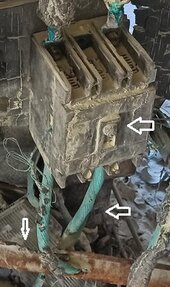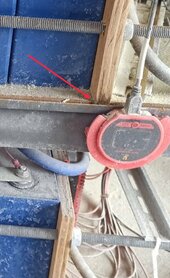robby
Photon Vampire
- Joined
- May 1, 2021
- Messages
- 4,178
Some of my Observation, which a few people have mentioned some of them already.
LOOK AT MY ARROWS:

1) The burned green copper is the wire that got the hottest and it's worst on the Right breaker in the zoomed in picture Above.
2) That is also the only breaker that is Still fully in the ON state. The other seemed to have worked properly, but that one failed.
3) The Wire is Frayed broke just at the point on the Table where it seems like the top half of the Metal Table bar has been welded by the Wire.
Thanks for sharing.
LOOK AT MY ARROWS:

1) The burned green copper is the wire that got the hottest and it's worst on the Right breaker in the zoomed in picture Above.
2) That is also the only breaker that is Still fully in the ON state. The other seemed to have worked properly, but that one failed.
3) The Wire is Frayed broke just at the point on the Table where it seems like the top half of the Metal Table bar has been welded by the Wire.
Thanks for sharing.




